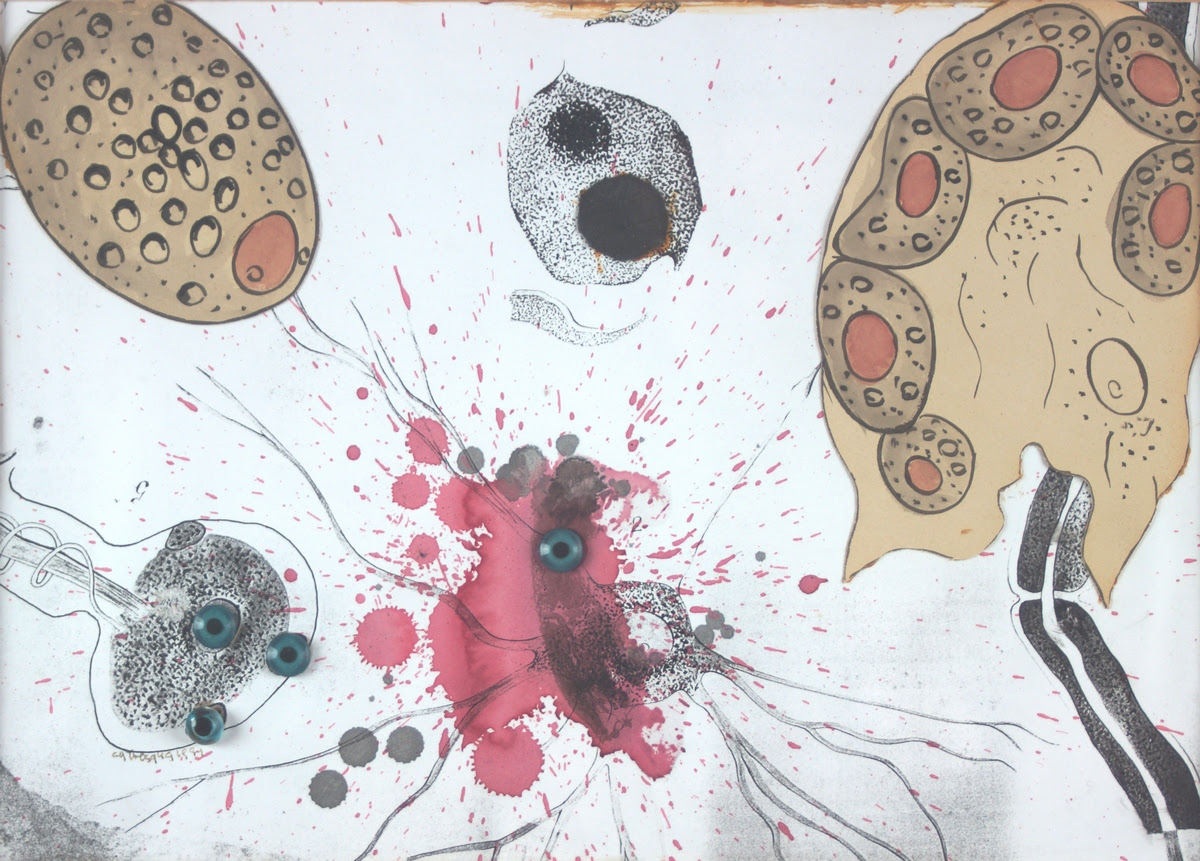Carol Rama – Le lacerazioni del mondo

Le particolari e intense opere di Carol Rama (Torino 1918 – 2015) hanno caratteristiche estetiche ed un gusto molto più vicino all’espressionismo austriaco e tedesco che non alla nostra tradizione mediterranea e solare.
Comunicato stampa
La De Primi Fine Art di Lugano è lieta di annunciare la mostra Carol Rama, le lacerazioni del mondo, visibile dal 14 settembre al 13 ottobre 2017. Il vernissage avrà luogo mercoledì 13 settembre, alle ore 18.
Le particolari e intense opere di Carol Rama (Torino 1918 - 2015) hanno caratteristiche estetiche ed un gusto molto più vicino all’espressionismo austriaco e tedesco che non alla nostra tradizione mediterranea e solare. Duramente provata dalla tragica e prematura morte di suo padre (probabilmente suicidatosi) e dai forti problemi psichici di sua madre, Rama ha sempre svolto il suo mestiere di artista come un’intensa autoterapia.
Nella Rama una forte sessualità vissuta insieme come gioco e colpa, felicità e paura, segno e cicatrice. Una carnalità fatta di corpi, volti, mani, presenze, insieme reali e impossibili, concrete e quasi surreali. Corpi o segmenti di corpi privati di ogni armonia; corpi e genitali e membra indagati come presenze ovvie ed oscene, vitali ed inquietanti. Curiosi, enigmatici occhietti avvolti tra vapori informali ci spiano come sentinelle di una coscienza acuta e moltiplicata. Piccole e misteriose scritte e segni indagano una razionalità che sfuma tra i grandi enigmi dell’esistenza. Figure femminili, autoritratti, intaccati da presenze ambigue, misteriose, tra l’organico ed il vegetale.
Come la sua bizzarra, lunghissima treccia di capelli legata alla sua fronte, un fiume di forme segue il vasto e strano ciclo delle metamorfosi, degli istinti, delle pulsazioni più profonde. Altri occhi, questa volta disegnati, dialogano con rosse lingue ironiche e beffarde, su fogli di altri disegni, altre tracce, altre stampe. L’armonia del corpo, nella Rama, è sempre intaccata e distrutta da una sessualità preponderante, violenta, ironica, malata. Un normale piede si confonde con una legnosa protesi; un ramo di foglie si trasforma in corona di spine.
Poi, in altri periodi, in altre opere, un netto allontanamento dalla figura umana, a favore di un gioco eminentemente formale ed estetico: il gioco delle camere d’aria; il nero della gomma, variamente declinato come tubo appeso, presenza, icona, elegante superficie nera. O, in altre opere di gusto informale, ancora una pausa dal vasto fuoco organico ed erotico, a favore di una ricerca estetica più pacifica, pacata, armonica.
Tra questi due principali temi, il percorso della Rama ha esplorato due mondi apparentemente opposti: l’universo espressionista, organico, riccamente corporeo in parte derivato da Egon Schiele; e quello formale, estetizzante e più lirico, in parte ispirato ad Alberto Burri. Da una parte il mondo della corporeità, della sessualità, fatto di lacerazioni, frammenti, tragiche divisioni e visioni. Dall’altra un universo ordinato, astratto, unito, dove l’armonia della forma ricompone ogni lacerazione. Così tutta la sua opera, come un inquieto pendolo descritto da Edgar Allan Poe, oscilla incessantemente tra i due inconciliabili poli della nostra esistenza: la lacerazione e l’unità, il caos e l’armonia, il frammento e la totalità, il fuoco e il cristallo.
De Primi Fine Art in Lugano is pleased to announce the exhibition Carol Rama. The lacerations of the world, from the 14th September to the 13th October 2017. Opening the 13th September, at 6 pm.
The particular and powerful works of Carol Rama (Turin 1918 - 2015) have aesthetic characteristics and a taste much closer to Austrian and German expressionism than to our Mediterranean tradition. Severely proven by the tragic and premature death of her father (probably suicidal) and her mother's mental problems, Rama conceived her artistic work as a self-therapy.
Rama experiences her strong sexuality as game and blame, happiness and fear, sign and scar at the same time. A carnality made of bodies, faces, hands, presences that are at the same time real and impossible, concrete and almost surreal. Bodies or segments of bodies deprived of all harmony. Bodies, genitals and limbs investigated as obvious and obscene, vital and disturbing presences. Curious and enigmatic eyes wrapped in informal vapors spying on us as sentinels of an acute and multiplied consciousness. Small and mysterious writings and signs investigating a rationality that fades into the great riddles of existence. Female figures and self-portraits, destabilized by ambiguous, mysterious presences, moving between the organic and the vegetable dimension. Like her peculiar long braid tied to her forehead, a river of forms follows the vast and odd cycle of metamorphoses, instincts and deeper pulsations. Other eyes, this time drawn, conversing with ironic and mocking red tongues, on sheets of other designs, other traces, and other prints. For Carol Rama, a prevalent, violent, ironic and sick sexuality disrupts and destroys the harmony of the body: a normal foot confuses with a woody prosthesis, a branch of leaves turns into a crown of thorns.
Then, at other times, in other works, a clear estrangement from the human figure, in favor of an eminently formal and aesthetic game: the game of air chambers. The black of the rubber, variously declined as a hanging tube, a presence, an icon, an elegant black surface. In other informal pieces, she still takes a break from the vast organic and erotic fire in favor of a more peaceful, harmonious aesthetic search.
Amid these two main themes, Rama's journey explored two seemingly opposing worlds: the expressionist, organic, richly corporeal universe partially derived from Egon Schiele and the formal, aesthetic and more lyrical universe, partly inspired by Alberto Burri. On one hand, the world of corporeality, of sexuality, made of tears, fragments, tragic divisions and visions. On the other hand, an orderly, abstract and united universe, where the harmony of forms recomposes every laceration. Thus, all her work, like the restless pendulum depicted by Edgar Allan Poe, rocks incessantly between the two irreconcilable poles of our existence: laceration and unity, chaos and harmony, fragment and totality, the fire and the crystal.



